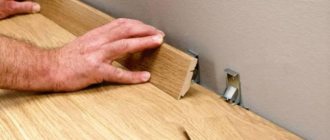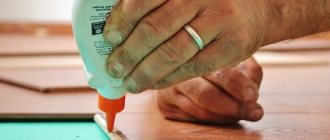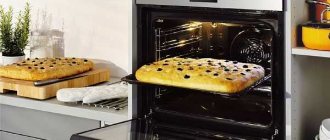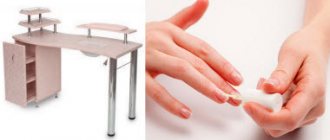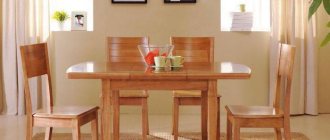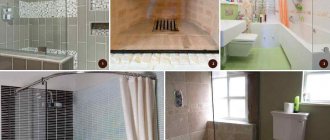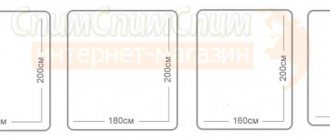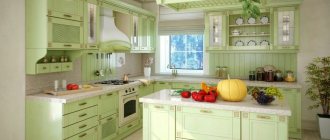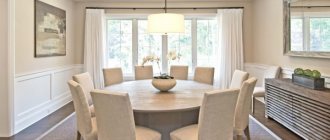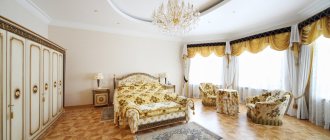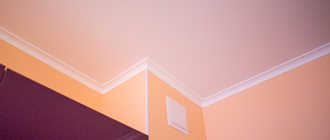Laminated chipboard - sheet size, thickness and cost of material, manufacturers
EGGER laminated chipboards have the following characteristics:
| Chipboard size, mm2 | Chipboard thickness, mm | Quantity per pallet | Pallet gross weight, t | Weight of one sheet, kg | Density, kg/m3 | Emission class |
| 2070*2800 | 8 | 24 | 1,13 | 47 | 660-670 | E-1 |
| 16 | 24 | 1,64 | 63 | |||
| 25 | 14 | 1,40 | 94 |
For detailed information on prices, see the price list page.
In our company you can buy moisture-resistant FSF plywood in Belgorod in any quantities.
FK plywood (birch plywood) is a medium-quality plywood grade in terms of moisture resistance, obtained by gluing birch veneer with urea adhesives. FK grade plywood can also be made on the basis of coniferous or mixed veneers.
The moisture-resistant qualities of FK plywood are less than those of laminated plywood and moisture-resistant plywood of the FSF brand , so it is used for finishing work indoors (and not outside). Also, FC plywood can be used in furniture production and for the manufacture of containers (boxes and boxes).
The abbreviation "FC" stands for the following:
- F - plywood
- K - urea glue.
Standard size of FC plywood sheet: 1525x1525 mm
Standard thickness of FC plywood: 3; 4; 5; 6; 8; 9; 10; 12; 15; 18; 21 mm
Grade of plywood FK Depending on the appearance and quality of the veneer of the outer layers, FK plywood comes in the following grades: I, II, III, IV
Type of plywood surface treatment FK Sanded on both sides (Sh2), unsanded (NS)
Regulatory requirements for FC plywood: in accordance with GOST 3916.1-96
Formaldehyde emission class E1 (up to 10 mg per 100 g of absolutely dry plywood), according to EN 717 Part 2 and A standard TN 1084.
Humidity of FC plywood: no more than 10%
Density of FC plywood: 640-700 kg/m3
Types of material
Can be classified according to several criteria. This could be dimensions, manufacturer, etc. One of them is quality characteristics. The material can be divided into 3 types:
- The first grade is considered the best, since it is made from one type of wood (for example, Wenge chipboard) and has a smooth surface without chips. Made from selected sawdust. On each side the sheet is laminated with a film or a layer of veneer is applied;
- The second grade is average and may have minor defects. It comes with or without cladding;
- The third grade is used only for construction purposes, has large defects on the surface and does not require cladding.
The facing of the material can also be varied. According to this principle, it is also subject to classification. Exist:
- Veneered sheets are finished with a thin layer of material. Such slabs are considered the best;
- Also laminated or finished with special paper;
- Rough sheets without facing.
The material is divided by size. The fundamental measure is thickness, which starts from 8 millimeters and ends at 38 mm. The average size is 16 mm and 18 mm.
Laminated chipboard has several quality characteristics
- Some types of chipboard material can be moisture resistant due to special impregnation with paraffin and the presence of wood fibers with moisture-resistant impregnation. This treatment resists moisture and swelling of the material.
- In addition to moisture resistance, it can be fire resistant if it contains fire retardants.
- This material is extremely easy to install. The size of the sheet allows you to adjust the dimensions of the slab to the required measurements. It is enough to cut the sheets according to the required measurements and put them into production.
- The slabs have a wide range of colors, which allows them to be used in various design styles.
- The material is considered one of the most economical because it has a relatively low price.
- Wooden slabs are durable and dry out over time.
Thanks to such a wide classification of materials, choosing the appropriate option is easy. A wide range of colors and quality characteristics makes this material relevant in different regions.
Such characteristics make laminated chipboard one of the most popular materials in construction and it is very easy to buy various types of slabs in Moscow.
You can buy laminated plywood in Belgorod or at any of our regional warehouses.
As is known, GOSTs regulating the quality of plywood provide for two classes of water resistance of plywood - ordinary waterproof plywood ( FK plywood ) and increased water resistance plywood (FSF plywood) . FSF plywood (moisture-resistant plywood) is made from birch veneer using phenol-formaldehyde adhesive resins. It is possible to produce FSF brand plywood from beech or pine veneer.
The use of phenol-formaldehyde resins determines such material qualities as good water resistance, mechanical strength and wear resistance. The abbreviation "FSF" stands for:
- F - plywood
- SF - resin phenol-formaldehyde glue.
Moisture-resistant FSF plywood is widely used in construction and finishing (both internal and external), for roofing work, in carriage building, and in automotive production. FSF grade plywood can also be used in monolithic construction as a deck for pouring concrete solutions.
Among the advantages of FSF plywood (in addition to moisture resistance and strength), one can also note the ease of processing: FSF plywood is excellent at sawing, drilling and fastening with both nails and screws.
Standard size of FSF plywood : 1220x2440 mm
Standard thickness of FSF plywood sheet: 6.5; 9; 12; 15; 18; 21; 24; 27; thirty; 35; 40 mm
Grade of FSF plywood Depending on the appearance and quality of the veneer of the outer layers, FSF plywood comes in the following grades: I, II, III, IV
Type of surface treatment of plywood FSF Sanded on both sides (Sh2), unsanded (NS)
Formaldehyde emission class E1 (up to 10 mg per 100 g of absolutely dry plywood), according to EN 717 Part 2 and A standard TN 1084.
Humidity of FSF plywood: no more than 10%
Density of FSF plywood: 640-700 kg/m3
Currently, FSF plywood is the most common type of plywood.
Features of laminated chipboards
Laminated chipboards are produced exclusively from high-quality polished chipboards in accordance with GOST 10632-2007. They do not have the disadvantages inherent in other particle boards: they are durable, resistant to steam, mold and moisture, chemical and mechanical stress, and a special melamine film and edge finishing significantly reduce the level of hazardous fumes and increase the wear resistance of the material.
Thanks to these characteristics, laminated chipboards can be used for the manufacture of furniture and interior decoration, including kitchens, hallways and bathrooms, wardrobes, office and children's furniture, and as flooring.
Laminated chipboards are presented on the market in a huge number of colors and textures, allowing you to imitate any material, including stone, marble, metal or fabric, and fit into any color scheme or interior style at a very modest cost.
Laminated chipboards do not require further processing or painting. To make furniture facades and tabletops, it is enough to cut the purchased sheet of chipboard in accordance with the specified dimensions and edge the edges.
The surface of laminated particle board can imitate natural wood
Important! It is necessary to treat the edge not only to increase the wear resistance and appearance of the material, to protect it from moisture and steam, but also to prevent the evaporation of harmful substances.
However, this is the main disadvantage of this material - the need for a special machine for sawing laminated chipboards and edging them. However, at present, any hardware store or furniture manufacturing workshop provides such a service as cutting laminated chipboard to customer sizes.
Another disadvantage is that due to the crumbling edge, such slabs are also not suitable for creating curved contours and complex carved elements.
How much laminate in one pack
Laminate of popular varieties can have from 6 to 10 boards in one pack. This includes most varieties:
- Kronostar;
- Kronoflooring;
- Tarkett;
- Pergo;
- Krono original.
This amount is usually enough to cover from 1.85 to 2.05 meters of area. With simple calculations, it is easy to establish that for a room of 12 meters you will need up to 7 packs, it is better to take it - if you need a supply, there will be somewhere to get it.
However, it is worth considering that this number may vary. Much depends on the manufacturer. Some people put 8 boards, some 10, for a laminate of a different area there may be only 7 boards in one pack. As an example, we can compare two large laminate manufacturers - Kronostar and Kronospan.
Thus, the manufacturer Kronostar for its Grungoff, Superior, Premier and Home collections, the board parameters of which are 1380 by 193 millimeters, puts 8 boards per pack.
The Salburg collection, which has similar parameters, is sold in only 7 boards per package, and Prime lin – in 9 boards. If you calculate the average, you can see that most often the manufacturer puts 8 boards per package.
Kronospan works a little differently. His collections have dimensions of 1285 by 192 millimeters. Among them are Castello and Kronofix, sold in 9 bars per pack. Quick Style is sold in 7 bars, Quick-Step Exquisa contains only 2 boards per pack, but Comfort - 10.
You can determine how many boards are in one pack of laminate using the information that the manufacturer necessarily publishes in the technical information for its product. The parameters of the bars themselves and the total area of the boards must also be indicated there.
Knowing this data, you can easily calculate offhand how many packs will be needed for each specific room.
Chipboard: sheet size. Basic indicators of length, width and thickness
Standard dimensions of laminated chipboard sheets are regulated by GOST. In accordance with this standard, the width, length and thickness of the slabs are determined.
Laminated chipboard with a processed edge is used for the manufacture of interior items
Main dimensions of laminated chipboard
There are 18 standard lengths: 1830, 2040, 2440, 2500, 2600, 2700, 2750, 2840, 3220, 3500, 3600, 3660, 3690, 3750, 4100, 5200, 5500 and 5680 mm. In this case, the permissible length inaccuracy is ±5 mm.
The width of laminated chipboard slabs is determined by 9 indicators: 1220, 1250, 1500, 1750, 1800, 1830, 2135, 2440 and 2500 mm. As with length, the permissible error does not exceed ±5 mm.
The thickness of laminated chipboard ranges from 3 to 38 mm with an acceptable inaccuracy of ±0.3 mm.
It should be clarified that, depending on the capabilities of the equipment, each manufacturer produces several basic sizes of chipboard, but the following are considered the most popular on the market:
- 2800x2620 mm;
- 2800x2070 mm;
- 2620x1830 mm;
- 2500x1830 mm.
Chipboard thickness ranges from 3 to 38 mm
Thickness of laminated chipboard sheets
Their strength and ability to resist loads, and therefore their scope of application, directly depends on the thickness of the laminated chipboard. It is important to remember that heavy thick slabs are very durable, but thin laminated chipboards bend without being deformed.
Most often, the thickness of laminated chipboard ranges from 8 to 38 mm. 8-10 mm sheets are used for the production of containers, drawer bottoms, door and wall cladding, as well as for furniture fronts.
Laminate size
After curing, the finished sheets are cut into panels. Laminate sizes vary. Its width can vary between 185-300 mm, and its length - 1180-2000 mm. Most manufacturers have chosen the most convenient parameters. The most common laminate size is: width – 185-195 mm, length – 1260-1380 mm. At the same time, high-quality material also has a greater thickness. The most reliable and wear-resistant flooring of this type can reach 14 mm. This laminate is not afraid of any floods or dancing in heels. Unscrupulous manufacturers produce panels that are sometimes about 5 mm thick. Despite the fact that the price of such a laminate will not be high, its durability is out of the question.
Furniture made from chipboard. Calculation.
I wanted to describe each point in detail, but I realized that there would be a lot of “water”, so ask any questions you have in the comments - I will answer all of them.
Also, I do not wish to replace the best master and do not want to offend anyone present here.
I will look at the furniture that is currently in my work in order to complement the picture with “live” photographs, proofs and show in more detail the assembly process.
!
I do all calculations only in millimeters.
So let's get started! We currently have the following cabinet at work:
Client – State institution. They usually choose everything cheaper and in standard colors.
I don’t see the point in drawing a new drawing every time, so I mainly discuss the issue with the image with the client in a notebook with a hand sketch.
A few words about chipboard.
We have three main suppliers:
EGGER – Usually the most expensive and highest quality;
Kronospan - Not much inferior in quality to EGGER and 20-30% cheaper in price;
Swisspan - The most budget option. This is what we will be looking at today. (Price in Ukraine:
450-500 UAH for our color)
People chose the color: Apple (In the picture) and thickness 16mm (The most common).
I haven’t yet said that chipboards come in two sizes: 2800x2070 and 2750x1830
We are interested in the second size.
Now we need to make a cutting map (This thing where they show how many of these chipboard sheets you need, the edge and how to cut)
I use Cutting3 because it's convenient for me. (Yes, yes, I tried Pro100, and Basis, and other programs, but this is the most convenient for me. And the simplest.)
On the left side (in the picture above) we enter our sheets, where:
1 – The material from which we make our cabinet (Actually, this point is not so important in this program);
2 – Dimensions of our sheet;
3 – The number of sheets that we need (We can immediately set it to 999, the program will then show itself exactly how much we will spend on the order);
4 – This is the width of the saw cut and it is advisable not to touch it.
5 – This is sawing the sheet to make a right angle and remove chips. You need to put it like this:
For cutting, take from 5 to 15mm, in our case we took 10mm. This is the norm.
Please note that if the cabinet has fronts made of 16mm chipboard, then you must subtract 20mm from its total depth.
Let's say we need to find the depth and width of the top and bottom of our cabinet. The width remains unchanged - 600mm. And our depth will be 450mm – 20mm = 430mm. This is done in order to reach the size we need and so that there is a gap (Millimeters that will save us later).
Now we know our top and bottom, as well as our quantity:
We set it to “rotate” because the structure is not important to us.
Next we need to calculate the stand (side wall of the cabinet). We take the total size of 2200mm, subtract from it the thickness of the upper (16mm) part and the lower (16mm). And subtract the height of the legs.
Our leg is D-50:
A description of almost every leg can be found on the Internet, for every taste and color.
2200mm – 16mm – 16mm – 27mm = 2140mm (I round to 0, sometimes 1mm can save you.)) Now we know the height of the stand, and we ALREADY KNOW the depth of our cabinet. Adding to the details:
!
We do not rotate only the facades.
We can easily rotate everything else.
Next we must insert our shelves, of which there are 5 pieces (As in the picture). We take the total width of 600mm and subtract two 32mm racks. And that's all, guys!
Knowing the depth, we get a part 568x430 and fit it in. All the same.
And the last thing is the facades. The standard height of such facades is 720mm. There should be two of them. That is, we divide the width of 600mm in half and get 720x300x2, where 2 is the quantity.
BUT! The facades are glued with an edge of two millimeters around the perimeter, so on each side we have to take them away and another millimeter for the gaps (Then they will save us again). As a result, we must subtract 6 mm from the length and 6 mm from the width.
Standard laminate sizes
When purchasing a laminate flooring, you should measure the room's footage in advance and accurately, and only then use this data as a basis when choosing slats in width and length. Each manufacturer has its own size and thickness of the laminate, as well as the number of boards in a pack. Most of them prefer to produce a similar finish for the floor in several standard variations. But on sale you can find material with non-standard dimensions for an original or original design.
Details about the dimensions, length, width and thickness of the laminate
So, the laminate thickness can be 6-12 mm. The average thickness is 8 mm. It is clear that the thicker the coating, the better it can withstand all kinds of loads. In addition, such a “reinforced” coating has minimal thermal conductivity, as well as stable dimensions.
The width of the board can also vary significantly. Thus, a material with a width of 90 mm belongs to a narrow canvas - such a coating will imitate a type-setting parquet floor.
The canvas imitating ceramic tiles will have a laminate board size of 330 mm in width. Most often you can find laminated planks with a width of 185...195 mm. With such dimensions, the canvas creates the maximum imitation of a wooden floor.
The length of the canvas is also not standardized. The most popular coating is considered to be 1260-1380 mm long, although the length of one board can reach 1845 mm. Using a long blade is problematic - in this case, the geometry of each of the planks must be maintained perfectly.
When choosing the size of the laminate, you must also take into account the geometry of the room. So, in a wide and long room, use coverings of appropriate dimensions. But for a small space, you may need “oversized” planks, since you will still be doing trimming.
Main settings
Typically, laminate is sold in the form of rectangular boards of different sizes with a pattern of texture of a particular tree. These are the most popular and sought-after options on the market. But laminate slats are also available in the form of squares with various patterns on the surface, as well as in a single color to resemble metal or other material.
Laminate can be wide, medium and narrow
The laminate labeling on the package indicates:
- class for strength and abrasion resistance;
- formaldehyde emission level;
- type of connection of laminate boards;
- length, width and thickness for one lamella;
- number of pieces in the package and their total area.
The dimensions of the laminate directly affect the appearance of unnecessary trimmings during installation of the coating. If you take slats that are too wide or long, you will have to cut more of them near the walls. However, it is often impossible to use such residues elsewhere on the floor. All this goes to waste, and the money was paid for the overall square footage of the finish. This results in unnecessary expenses, which can be completely avoided by correctly calculating the volume of required material at the very beginning.
Marking on laminate packaging
Length
The most popular length among manufacturers is considered to be 126–138 cm. Laminate with a size within these limits is easy to transport and install. It is even easier to work with shorter boards, but transporting them is more difficult due to the larger number. You can also find narrow lamellas with a length of up to 2 meters in the store, but their installation is fraught with serious difficulties. For self-installation, this option is not worth taking.
The less you have to trim the laminate during installation, the more beautiful the assembled coating will look later. Plus, it is much easier to carry, try on the floor and cut boards that are just over a meter long than larger laminate plates.
For small rooms, it is recommended to take small slats. They will look more harmonious in the interior and not as cumbersome as their longer counterparts. The joints of individual elements of the laminate finish are only barely noticeable at first glance. After laying the covering, these seams and dimensions of the boards are still clearly visible on the floor.
Basic dimensions of laminate
Width
The width of the laminate is also not limited by any standards. The manufacturer himself decides what laminated products will be in his collection. Here, the pattern on the surface of the lamella and the overall design of the coating play an important role. The entire range of laminate flooring according to the width of the board can be divided into three groups:
- Narrow 90–160 mm.
- Average 160–195 mm.
- Wide – up to 350 mm or more.
The first ones are usually an imitation of narrow parquet planks. The latter are among the most common; the pattern of wood fibers on them looks as natural as possible. Third, this is often an attempt to create a copy of the tile, a kind of “laminated tile” for installation, for example, in the kitchen.
Thickness
The thickness of the laminate greatly influences the strength of the board and its durability. The thicker the lamella, the longer it retains its dimensions under loads and the more reliable the locking connections are. If you take an option that is too thin and place heavy furniture on top, the covering will inevitably and quickly sag under the legs of sofas or tables. And no heavy-duty substrate will save you here.
The following parameters are considered standard thickness dimensions for lamellas:
A number of manufacturers also produce cheap laminate with a very small thickness of 6–7 mm. But these products are practically not in demand among buyers. They provide a slight increase in height for the decorative covering, which is especially important if the screed is made thick or you had to use a high backing. However, this option is too soft and has low strength.
What thickness to choose laminate
If the thickness of the laminate exceeds 12 mm, then it is most often a moisture-resistant board belonging to class “33” or “34”. This coating can withstand high loads for many years without damage and is more resistant to wear.
At the same time, thick lamellas conduct heat worse. On the one hand, the floor decor made from them turns out to be more comfortable for walking barefoot, but on the other hand, it is impossible to install a “warm floor” under such a finish. In the second case, a significant part of the energy will be wasted on heating the wood, without benefiting the people in the room.
The weight of the lamella is affected not only by the size of the board, but also by the material and technology of its manufacture. The simplest case is when the load-bearing base is plywood. But laminate is a multi-layer cake. And there are products with additional layers of durable, moisture-resistant plastic and not plywood, but MDF or HDF.
Each of these options weighs its own kilograms. If this point is critical, then it should be clarified with the seller of a particular laminate and carefully look at the inscriptions on the packaging. The weight of the pack with boards must be indicated there.
How thick is laminate?
Laminate is divided into several classes, due to which it is possible to distinguish and indicate the level of wear resistance and the service life of the coating. Its thickness also largely depends on this.
The board is a multi-layer structure:
- The upper one does not affect the thickness, it is only responsible for wear resistance. Presented in the form of a laminating film made on the basis of melamine or acrylic. The purpose of the layer is to protect the lamella from mechanical influences, ultraviolet radiation, and high humidity.
- Decorative layer (located under the top one, also does not have a significant thickness). Presented in the form of foil or paper. It can be made in one tone or with a pattern that exactly imitates the texture of natural materials.
- The main layer is high-density wood board. the reliability of the locking system, the efficiency of installation work, the strength indicators and the practicality of using the coating in domestic and commercial premises depend on it
- The bottom layer is tarred kraft paper, the purpose of which is to protect the panel from a humid environment. It also prevents the possibility of friction between the board and the substrate, which in turn minimizes the premature destruction of the laminate.
Manufacturers offer three main classes of laminate , which vary both in physical and mechanical properties and in thickness. The product class indicates in what conditions the coating can be used, what loads it can withstand, and how long it will last.
So, what you need to know about the class of this flooring:
- Class 32 – varies from 6 to 7 mm , considered a budget coating option. Designed for domestic use in low-traffic areas (bedrooms, dressing rooms), as well as for commercial installation in low-traffic areas. Experts do not recommend laying laminate of this class throughout the entire apartment, as this will lead to the need for repeated repairs in the near future.
- Class 33 - standard coating, 8-10 mm , intended for installation throughout the house, as it can withstand high loads. If such products are selected for an office, then installation is possible in rooms with average traffic.
- Class 34 - laminate with a thickness of 10-12 mm , with enhanced properties. Laying such a coating is possible in corridors and areas with high traffic.
The last option is the most durable. Its strength indicators are superior to other options. Despite the high cost, the products pay for themselves due to durability and preservation of the original appearance for a long time.
But let’s just say from our own experience: for a simple apartment or house, 33 classes are quite enough.
Standard sizes
When deciding which laminate is best to choose for an apartment, it is very important to choose the right size. The more carefully the calculations are made at the very beginning, the less scraps that will have to be thrown away later.
At the same time, standard sizes simplify the preparation of a flooring project, but non-standard sizes make it possible to create a unique design. What is more important - ease of installation or a more visually interesting finish on the floor - everyone will have to decide for themselves. There is no universal answer here.
Popular laminate sizes for home
Laminate size - choose standard
Laminate is a modern floor covering consisting of layers of chipboard, resin paper and fiberboard. Today this option is considered one of the best finishing materials; it is attractive in appearance, appropriate in any interior and durable. Let's consider its texture, and also pay attention to the standard size of the laminate.
When arranging their home, every person wants to see only high-quality finishing materials in it, so they are often too biased towards them. But laminate has obvious advantages over other coatings:
- A quick and easy way to install and assemble.
- Affordable prices.
- Minimal care.
- If chosen correctly, it can withstand heavy loads.
- Perfectly complements any design solution.
- Long service life.
- Environmentally friendly.
- Resistant to temperature changes.
When choosing a floor covering, you need to take into account not only its positive qualities, but also its technical characteristics. This way, you can provide your home with the highest quality flooring.
Material texture
The texture of the laminate refers to its pattern; it is applied to the penultimate layer of coating. The pattern often imitates natural materials. It is generally accepted that laminate almost always recreates wood. At the same time, its designers and developers carefully approach the issue of texture and select the pattern of the most expensive and beautiful types of wood.
Today there are a large number of laminate textures, this allows you to increase the range and gives you the opportunity to choose. The coating can display not only wood, but also tiles, marble, and natural stone.
The seamless texture of laminate is very popular. The picture is applied to the lamellas so that when laid, the surface becomes monolithic, the joints and seams are completely invisible. The joints exist, but the visual effect completely hides them. This is also affected by the special installation technique.
The seamless texture is divided into fine-grain and synchronous. The first perfectly imitates wood. The second is responsible for the appearance and can give the laminate the appearance of valuable species. Using two textures and rustic embossing, the manufacturer receives a high-quality image indistinguishable from a natural product.
Related article: 3D tiles for the bathroom - immersion in another dimension
In addition to texture, editing is important. In order for the floor to truly become monolithic, it is necessary to lay it perpendicular to the wall, from where the light will come, and parallel to the rays of the sun.
In addition to textured, there is a smooth laminate. The difference is that to create texture on the decorative layer, graphic work is carried out. The glossy finish has its advantages: it washes well, but traces of dirt are more noticeable on it, and such slats are very easy to install.
There is also a matte shade. Its privilege is that no greasy marks (footprints, etc.) remain on the surface of the material.
When choosing a material, designers are guided by the created image, so the flooring can be selected at the last stages of interior design.
Material Dimensions
Installation of laminate largely depends on the size of the lamellas. It is he who dictates the rules of installation.
The thickness of the laminate varies. The thinnest board is 6 mm, the thickest is 12 mm. The thicker the board, the stronger and more reliable it is, but due to various circumstances, boards with a thickness of 8 mm are most often purchased. This is the best option in terms of quality and price.
Thicker boards can withstand intense loads more easily, they remain warm at any air temperature, and the large size of the lamella greatly simplifies cleaning.
The width of the board is a criterion on which the stylistic decision will depend. Using a minimum size of 90 mm, you can imitate parquet, using boards with a width of 330 mm, you can make a floor in the form of a ceramic coating. Most often, medium-width laminate is purchased, it has simple installation, and manufacturers supply more lamellas of 185-195 mm.
The length of the board can be completely different. This indicator also plays an important role in the form of flooring, although it has no significance when creating a monolithic floor. Due to the fact that during assembly it is necessary to adhere to the correct geometry, the consumer prefers to buy medium-length laminate. This size is 1250-1400 mm. Larger boards are difficult to install by non-professional installers. Also, the middle slats are easier to dismantle.
Article on the topic: What is water-dispersion paint - its advantages and features
What does laminate consist of?
When creating the style of any room, its owner must know what finishing materials will be present there, and what they consist of, whether they are environmentally friendly to use, and what shelf life they have.
The laminate has 4 layers:
- The first layer is a protective coating, a transparent film that is not visible. Thanks to it, the laminate is used more profitably, it protects it from external aggressors. Most often, the layer is created from special resins; less often, minerals can be added. Thanks to the top layer, the floor can be washed with water and chemicals.
- After the protection comes the drawing itself. The decorative layer can be of different colors; most often the laminate is styled to look like beautiful wood.
- The main layer is fiberboard. The quality and quantity of wood determine the cost of the material. The quality of the wood itself is not as important as its processing processes. Good pressing provides warm floors, sound insulation, and elasticity. Locks are also made from fiberboard to help secure the slats together.
- The bottom layer can consist of different materials. More often, manufacturers produce lamellas with resin-impregnated paper, less often with plastic. The outermost layer protects the board from deformation and ensures stability. Thanks to it, the laminate can be laid as smoothly as possible.
Which laminate is better to choose
Purchasing flooring is a big decision because flooring is typically used longer than any other finishing material. It is worth taking an interest in the shelf life; in the case of laminate it is at least 15 years. When choosing, you should also pay attention to the size of the boards; the quality of installation depends on it. Experienced builders recommend that beginners use standard lamella sizes during installation.
The best posts
- How to make a plasterboard ceiling in the hallway yourself
- Installing a skirting board on a kitchen countertop
- How to connect an infrared heated floor
- How to properly cut a baseboard using a miter box
- Technology for installing a socket on a baseboard - advice from experts
- How to soundproof a floor in a panel house
- Do-it-yourself dust removal of concrete floors or floors
- Gfl (gypsum fiber sheet) for flooring - what is it
Related article: Attaching the cable channel to the wall: installation stages
